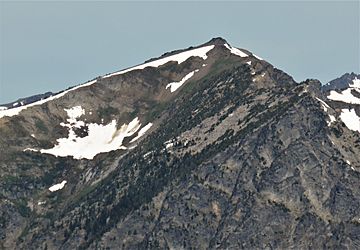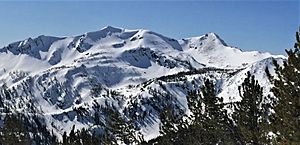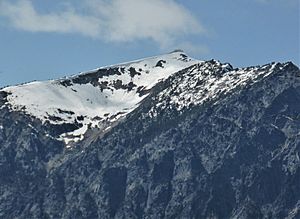Big Lou facts for kids
Quick facts for kids Big Lou |
|
|---|---|

Big Lou from southeast
|
|
| Highest point | |
| Elevation | 7,780 ft (2,370 m) |
| Prominence | 1,220 ft (370 m) |
| Isolation | 4.9 mi (7.9 km) |
| Parent peak | Snowgrass Mountain (7,993 ft) |
| Geography | |
| Location | Chelan County Washington state, U.S. |
| Parent range | Chiwaukum Mountains Wenatchee Mountains Cascade Range |
| Topo map | USGS Big Jim Mountain |
| Climbing | |
| Easiest route | class 2 hiking West ridge |
Big Lou is a mountain summit in Chelan County, Washington state. It stands at 7,780 ft (2,370 m) tall. The mountain is about 8.5 mi (13.7 km) west-northwest of Leavenworth. It is located on the edge of the Alpine Lakes Wilderness. The land around it is managed by the Okanogan-Wenatchee National Forest.
Big Lou is the highest point on Icicle Ridge. It is also the third-highest peak in the Chiwaukum Mountains. These mountains are part of the larger Cascade Range. The closest taller mountain is Snowgrass Mountain, about 5 mi (8.0 km) to the northwest. Big Jim Mountain is slightly lower and is 1.75 mi (2.82 km) to the north-northeast. Water from Big Lou flows into Icicle Creek and other streams. These streams eventually join the Wenatchee River.
Even though Big Lou is not the tallest mountain, it rises very steeply. It goes up 5,200 ft (1,600 m) from the Icicle Creek Valley in only about two miles. Big Lou is named after a famous mountain climber named Lou Whittaker. He was the twin brother of Jim Whittaker, who was the first American to climb Mount Everest.
Understanding Mountain Weather
Most of the weather that affects mountains like Big Lou starts over the Pacific Ocean. These weather systems, called fronts, move east towards the Cascade Mountains. When these fronts hit the tall peaks of the Cascades, they are forced to rise. As the air rises, it cools down. This causes the moisture in the air to turn into rain or snow. This process is called Orographic lift.
Because of this, the Cascade Mountains get a lot of rain and snow. This is especially true during the winter months. In winter, the weather is often cloudy. However, in summer, high-pressure systems over the Pacific Ocean become stronger. This often means there are very few clouds. The best time to visit or climb Big Lou is usually from June through October. This is when the weather is most clear and pleasant.
How Mountains Are Formed
The Alpine Lakes Wilderness area has very rugged land. It features sharp peaks, long ridges, and deep valleys carved by glaciers. There are also huge granite rock walls. More than 700 mountain lakes dot the landscape. Long ago, major geological events shaped this area. These events created the varied land and huge changes in elevation. This also led to different climate zones across the Cascade Range.
About two million years ago, during the Pleistocene period, large sheets of ice called glaciers moved across the land. These glaciers advanced and then melted back many times. As they moved, they scraped away rock and left behind rock debris. The last time glaciers melted in the Alpine Lakes area was about 14,000 years ago. By 10,000 years ago, they had moved north of the Canada–US border. The river valleys in this area have a "U"-shape. This shape was created by these recent glaciers.
The tall peaks and deep valleys of the Alpine Lakes Wilderness were formed by two main processes. One is uplift, which means the land was pushed up. The other is faulting, where the Earth's crust breaks and moves. These processes, along with the action of glaciers, created the stunning mountain landscape we see today.





